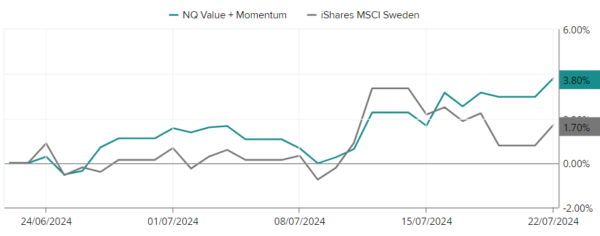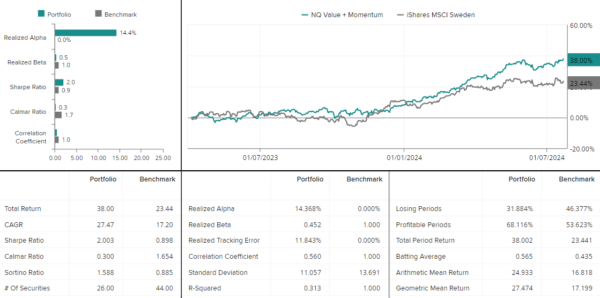Changes in the model portfolio Value & Momentum

The strategy combines the factors of value and momentum to find companies that are trading with strong momentum, but which are also attractive based on valuation multiples.
By combining the factors, we avoid potential value traps. We also avoid momentum stocks that are trading well above their fundamental value and are vulnerable to correction.
Development last month
The portfolio has outperformed the index performance over the past month. +3.8% compared to the Stockholm Stock Exchange which rose by approximately 1.7%.
 Top positive contributors have been Inwido (+0,69), Pareto (+0.60) and Must (+0,55).
Top positive contributors have been Inwido (+0,69), Pareto (+0.60) and Must (+0,55).
The biggest drag on the portfolio has been Kid (-0,41), Scandi Standard (-0,23), Jyske Bank (-0,21).
Development since start 2023
Value & Momentum has had a good performance since the start of April 2023. A higher return at a lower volatility has provided a high risk-adjusted return.
Traton, Advance Gas, SEB has been the largest positive contributor since the start.

Holdings and monthly changes
Login required to view holdings.
Not a customer? Open an account to access our analytics service.
Frequently asked questions
Where can I find the holdings and portfolio weights?
You can find our holdings and weights on the page Model portfoliosYou can also filter model portfolios via watchlists on several pages in the platform.
Can I export portfolios to Excel?
On the page Model portfolios The platform allows you to export to Excel. Select the portfolio and then click the download icon at the top right of the page.
How often are the portfolios updated?
Our model portfolios are updated approximately once a month. The frequency is a trade-off between several factors, such as transaction costs and administration, which are weighed against the benefit of frequently resetting risk. For the model portfolios we offer today, rebalancing once a month works well. If a stock falls by 20%, this means a decline in the portfolio by 1% if we have 20 stocks in the portfolio with a 5% weighting in each. Major price drops are not a disaster unless we have very concentrated portfolios.
Do I have to rebalance the position if the target weight does not deviate significantly?
We rebalance to restore the risk we have allocated. We allocate 10 bps (0.10%) to each holding. During a “normal” day, the holding should affect the portfolio by 0.1%. If the target weights do not deviate significantly from your current position size, you save time and transaction costs by not rebalancing.
What do volatility-adjusted portfolio weights mean?
We want to treat all companies in the portfolio equally, that is, all companies should have the same theoretical chance of affecting the portfolio. We do this by adjusting the weight of the holdings according to the volatility of the stock. A stock that fluctuates a lot will therefore have a lower weight in the portfolio. If we were to weight all holdings equally, the most volatile stocks would characterize the development of the portfolio, and this is not optimal unless the holdings have the same volatility. This method also leads to us reducing the position size in holdings that are starting to fall, since declines often covary with increased volatility.
How many stocks are in the portfolios?
The number of stocks in the portfolios varies between about 20 and 30 holdings. We use a method where the number of stocks is just right to achieve the effects of diversification. If we have fewer than 20 companies, the company risk starts to increase for individual holdings. High company risk is something we want to avoid because we are agnostic and do not “bet” on individual companies.
Do you use stop loss?
No, we do not use stop losses in the model portfolios. If a holding falls out of the ranking during monthly rebalancing, the stock is sold. But there are no stop losses. For shorter strategies such as swing trading, we recommend stop losses. This means that before entry, you determine a level at which you will sell if the position goes against you, either directly in the software or by recording the level.
Should you track all stock portfolios?
No, you don't have to. The important thing is that you have time to manage the portfolios, even during weaker periods when it is more tedious to log in to the account. We currently have three stock portfolios. This can change. Over time, the stock portfolios have a high correlation with the stock market. After all, we buy stocks. Follow the concept that you believe in. Learn to make your own decisions. If you don't strongly believe in the concept, you won't follow the strategy during weaker periods. The best strategy is the strategy we can maintain over time.

